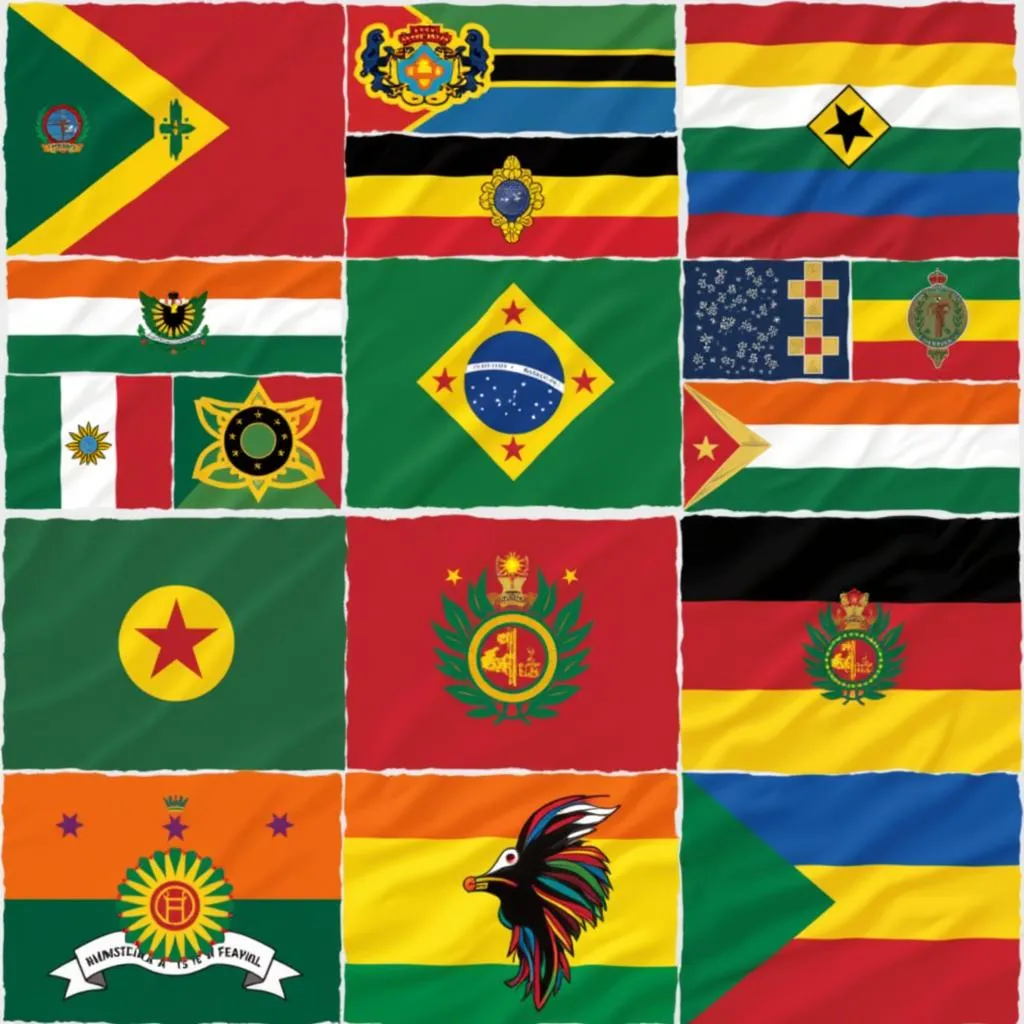The colors on African flags are more than just hues; they represent the history, culture, and aspirations of diverse nations across the continent. From the fiery red of liberation to the serene blue of unity, each color tells a story, reflecting the struggles and triumphs of the people. Let’s explore the vibrant tapestry of colors that adorn the flags of Africa and unravel the symbolic meanings they hold.
The Pan-African Colors: A Symbol of Unity and Identity
The most prominent colors found on African flags are green, yellow, and red – often referred to as the Pan-African colors. These colors hold deep historical and cultural significance, symbolizing the shared heritage and aspirations of the African people.
- Green: Represents the lush landscapes and natural wealth of Africa. It also symbolizes hope, growth, and prosperity.
- Yellow: Symbolizes the abundance of sunshine, the lifeblood of the continent, and the mineral wealth found in many African nations. It also represents joy, optimism, and the promise of a brighter future.
- Red: Represents the blood shed during the struggle for independence from colonial rule. It is a poignant reminder of the sacrifices made by African freedom fighters and symbolizes courage, strength, and the pursuit of liberation.
These powerful colors, often displayed together, represent the collective identity and unity of African nations. They embody the shared history, struggles, and aspirations of a continent striving for progress and self-determination.
Beyond the Tricolor: Exploring Other Prominent Colors
While green, yellow, and red dominate the color palette of African flags, several other colors hold significant meaning:
- Black: Represents the people of Africa, celebrating their resilience, strength, and determination. It also symbolizes the shared African heritage and the rejection of colonial oppression.
- White: Symbolizes peace, harmony, and unity. It represents the desire for cooperation, understanding, and progress among all people.
- Blue: Represents the vast sky and oceans that surround the continent. It symbolizes peace, tranquility, and the hope for a brighter future.
These additional colors, often used in conjunction with the Pan-African colors, add depth and complexity to the stories told by African flags. They reflect the diversity of cultures, beliefs, and aspirations within the continent, highlighting the richness and vibrancy of African identity.
 African Flag Colors Diversity
African Flag Colors Diversity
The Influence of History and Culture
The colors chosen for African flags are deeply rooted in the continent’s history and culture. Many flags reflect pre-colonial symbols and traditions, reclaiming cultural identities suppressed during colonial rule. For example, the Ethiopian flag, one of the oldest in Africa, features a prominent yellow star on a green, yellow, and red background. The star symbolizes the bright future of Ethiopia, while the colors represent the country’s rich history and cultural heritage.
“The colors of our flag are not just symbols; they are the threads that weave together the tapestry of our history, our present, and our future.” – Chinua Achebe, a renowned African writer, perfectly encapsulates the profound meaning behind the colors adorning African flags.
A Celebration of Diversity and Unity
The colors of African flags represent the continent’s rich tapestry of cultures, histories, and aspirations. They are a powerful symbol of unity and identity, reflecting the shared heritage and future aspirations of a diverse and vibrant continent. From the fiery red of liberation to the serene blue of unity, each color tells a story, reminding us of the struggles and triumphs that have shaped Africa’s past, present, and future.
 African Flag Unity Celebration
African Flag Unity Celebration
FAQ
1. What is the most common color on African flags?
Green is the most common color found on African flags, symbolizing hope, growth, and the continent’s lush landscapes.
2. What do the Pan-African colors represent?
The Pan-African colors – green, yellow, and red – represent the shared heritage and aspirations of the African people, symbolizing hope, unity, and the struggle for liberation.
3. Why do some African flags feature a star?
A star on an African flag often symbolizes hope, guidance, and the pursuit of a brighter future. It can also represent unity and the guiding principles of the nation.
4. How do African flags reflect the continent’s history?
Many African flags incorporate colors and symbols that predate colonial rule, reclaiming cultural identities and celebrating the continent’s rich history and heritage.
5. Why is understanding the meaning of flag colors important?
Understanding the symbolism behind flag colors provides insight into the history, culture, and values of a nation. It fosters respect and appreciation for the diverse identities represented across the African continent.
Need More Inspiration?
- Discover the fascinating story behind what color is a lion’s mane and its cultural significance.
- Delve into the world of iconic figures and explore what was Jackie Robinson’s favorite color and its impact on his legacy.
Connect with Color Box Hanoi
Need help creating a space as vibrant and inspiring as the colors of Africa? Contact our team of color experts at Color Box Hanoi. We’re here to help you transform your home into a stunning reflection of your unique style.
Call: 0373298888
Email: [email protected]
Visit: 86 Cầu Giấy, Hà Nội
Our team is available 24/7 to answer your questions and help you bring your color dreams to life.

